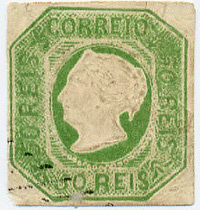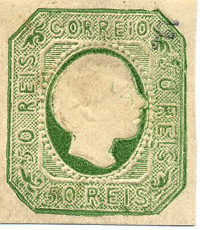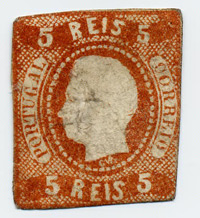
Stamps have everything for them as a collecting subject: beauty, rarity and variety... however they are catalogued! A catalogue of stamps of Portugal will list every issue, major variety and error that ever existed and the probability of new finds is slim indeed. Forgeries, on the other side, are a largely unexplored territory: the origin, date and details of many issues are utterly unknown, they are not listed in an exhaustive way, and many forgeries are still to be recognized as such. Also, they are being generated as I write and a full listing will never be possible.
I do not collect stamps but I do collect forgeries, and the genuine stamps I buy are intended for reference and comparative study. So, this introduction to the forgeries of Portugal is written from the point of view of a collector of forgeries. The systematics are very different from those used by philatelists but otherwise the data included in my site will be useful for both philatelists (who try to avoid being tricked into buying forgeries), as well as to forgery collectors (who want to avoid buying genuine stamps). Since forgeries are usually less valuable than stamps, forgery collectors have the easier task in avoiding the wrong stuff!

First of all, my definition of forgery is a cinderella printed from a plate of any type that was made or used specifically as a tool to imitate authentic stamps with deceitful intent.
As a consequence of this definition, a computer printout is not a forgery and neither is a handmade stamp imitation. Original stamps that have been tampered with are not forgeries unless the tampering involved the manufacture of a printing plate of any material. Thus a forged overprint or surcharge printed over a genuine stamp is a forgery, but it is exactly the very same forgery if it is also printed over a forged stamp (total forgery).
Stamp images printed with deceitful intent from appropriated original plates are forgeries (irrespective of the legal or illegal nature of the appropriation of the original plates). Official reprints are not forgeries even if falsely postmarked, nor are any falsifications based solely on a forged postmark (as far as we are concerned, that is).
Paper items printed in the likeness of stamps for other purposes than to pass them as authentic stamps (e.g. postcards or albums that reproduce stamps) are not forgeries irrespective of the use given to them (e.g. the cutting of stamp images from larger printings) and/or of false postmarks intended to cover any telltale differences. Cinderellas printed in the likeness of stamps without deceitful intent should make their purpose clear, e.g. by being made of a noticeably different size, or have a purposely different pattern, or then include a warning text within the frame of the stamp. But if someone produces a run ommiting the warning signs for the purpose of deceiving, then that run is a forgery.
When unsure of the status of a Cinderella that has the same general dimensions of the stamp it imitates and does not bear any warning text, one should not consider it a forgery, unless examples are known in which it has been repeatedly been offered as a genuine stamp (for instance, after being canceled with a postmark).

From the point of view of a forgery collector, stamp forgeries may be divided into three categories: i) forgeries that are printed as such; ii) forgeries that are made up from genuine stamps; iii) forgeries that are made up from prints that were not themselves intended to deceive. Besides these, there are forgeries of other sort, intended to deceive collectors of covers, collectors of cancellations, etc., that are beyond the scope of these pages.
1-Forgeries printed as such. This category comprises three basic subgroups: forged stamps based in redrawn designs (in this case the forged stamp is printed after an altogether new drawing made to imitate an existing stamp); forged stamps in which an original plate was used or then the existing design was photographically or digitally transferred to a plate (in this case the design itself will often be faultless); and finally forgeries in which a stamp is printed from several plates that were photographically obtained from different stamps. This last case is an option to cut costs when series of similar stamps must be produced (for instance the Portuguese colonial Crown stamps). The final design will be a composite of several prints when the original stamp was obtained from a single printing and will likely be not altogether perfect.
2-Forgeries made from genuine stamps. This group includes forgeries made up by means of fake surcharges or overprints over genuine stamps (this is probably the commonest type and often quite uninteresting).
3- Forgeries resulting from the mischievous use of other prints. This group includes two subgroups: official reprints that are used as a basis to which are applied, for instance, forged overprints to make them pass for genuine original stamps; or else the same over other prints (including catalogue illustrations).
The most interesting forgeries of all come from Group 1 and, very particularly, when an altogether new drawing is produced. Naturally my pages will particularly focus in such cases. Digital forgeries, on the other hand, are easily produced with modest technical means and are practically devoid of interest.

Forged overprints and surcharges are not particularly interesting, except in those cases where, because originally intended to substantially increase a charge, the surcharge is carefully designed to make it hard to forge. Cases like the overprint "REPUBLICA" which do not represent an increased charge were often carelessly produced originally and can subsequently be forged with a mere rubber stamp. Such cases are amidst the least interesting of forgeries. Whenever a simple overprint represents an increased philatelic value, it will undoubtedly be forged again and again to extract an added value from eager philatelists.
Official reprints are often printed from the original plates or dies. As such they are a forger's dream and whenever they are considerably less valuable than the originals, forgers will try and pass them for genuine period stamps. For that reason, the reprints of valuable stamps will be addressed in my pages, even if they don't fall within my strict definition of forgeries..
If I were to group the forgeries of Portuguese stamps in clusters, four would immediately jump to mind: the cluster of embossed (and mostly imperforated stamps); the cluster of colonial Crown stamps; the cluster of the Mozambique Company elephant stamps; and the Native stamps of the Portuguese State of India. All the other forgeries could conveniently be grouped together in a fifth bungled group.
My pages will have a rather large section on embossed stamps (including the reprints), and also a representative section on the colonial Crown stamps. In all cases, the revealing details will be reproduced at a convenient scale for comparative purposes. The Indian native stamps and the elephant stamps will be displayed as they become available. Of the remaining forged stamps, the most commonly encountered will also be illustrated in individual pages.
Forged surcharges and overprints will usually not be mentioned, unless truly exceptional for their quality or for the added philatelic value they would represent, were they authentic.
Books are still the preferred medium for obtaining information and both the philatelists of Portugal and Colonies and the forgery collectors are lucky in having a good reference title on the subject of forgeries, printed in England in 2002 and which is the bible on the matter:
Davies, D.J. "Forgeries of Portugal and Colonies"
Other recommended books are:
Tyler, Varro E. "Philatelic Forgers- their lives and works" (fascinating biographies of known forgers);
Vieira, A. "Selos Clássicos de Relevo de Portugal" (not a book on forgeries but an excellent reference on the original embossed issues and their reprints).
| Índice geral de textos sobre falsos |